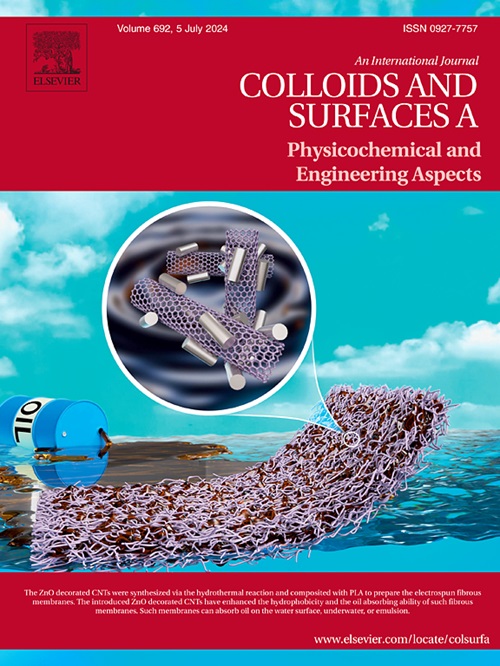Effect of sodium citrate on the expansion of clay minerals during leaching process of ionic rare-earth ores
IF 5.4
2区 化学
Q2 CHEMISTRY, PHYSICAL
Colloids and Surfaces A: Physicochemical and Engineering Aspects
Pub Date : 2025-07-25
DOI:10.1016/j.colsurfa.2025.137869
引用次数: 0
Abstract
During the leaching process of ionic rare-earth ores, the swelling of clay minerals can cause severe problems including landslides. The swelling behaviors of halloysite, kaolin, montmorillonite, and illite were investigated in this work. The regulatory mechanisms of these inhibitors on the swelling behavior of the four clay minerals were systematically studied by combining 0.20 mol/dm3 magnesium sulfate with sodium citrate solutions of different concentrations. Linear swelling experiments were conducted to measure the swelling rates of each clay mineral in sodium citrate solutions at different concentrations. Analytical techniques such as XRD, FTIR, ζ-potential measurements, and TG analysis were employed to elucidate the action mechanisms. Results indicate that when magnesium sulfate is combined with 0.02 mol/dm3 sodium citrate, the swelling inhibition rate for halloysite reaches 25.20 %; with 0.05 mol/dm3 sodium citrate, the inhibition rate for kaolin is 12.48 %; and with 0.09 mol/dm3 sodium citrate, the swelling inhibition rates for montmorillonite and illite are 18.46 % and 35.53 % respectively. This research provides a theoretical basis and technical reference for the green and efficient inhibition of clay mineral swelling during the mining process of ionic rare-earth ores.
柠檬酸钠对离子型稀土矿浸出过程中粘土矿物膨胀的影响
在离子型稀土矿浸出过程中,粘土矿物的溶胀会引起山体滑坡等严重问题。研究了高岭土、高岭土、蒙脱土和伊利石的溶胀行为。通过将0.20 mol/dm3的硫酸镁与不同浓度的柠檬酸钠溶液结合,系统研究了这些抑制剂对4种粘土矿物溶胀行为的调控机制。采用线性溶胀实验测定了不同浓度柠檬酸钠溶液中各粘土矿物的溶胀率。采用XRD、FTIR、ζ电位和TG分析等分析技术阐明了其作用机理。结果表明:当硫酸镁与0.02 mol/dm3柠檬酸钠复合时,对高土的溶胀抑制率达到25.20 %;0.05 mol/dm3柠檬酸钠对高岭土的抑制率为12.48 %;柠檬酸钠用量为0.09 mol/dm3时,蒙脱土和伊利石的溶胀抑制率分别为18.46 %和35.53 %。本研究为离子型稀土矿开采过程中绿色高效抑制粘土矿物溶胀提供了理论依据和技术参考。
本文章由计算机程序翻译,如有差异,请以英文原文为准。
求助全文
约1分钟内获得全文
求助全文
来源期刊
CiteScore
8.70
自引率
9.60%
发文量
2421
审稿时长
56 days
期刊介绍:
Colloids and Surfaces A: Physicochemical and Engineering Aspects is an international journal devoted to the science underlying applications of colloids and interfacial phenomena.
The journal aims at publishing high quality research papers featuring new materials or new insights into the role of colloid and interface science in (for example) food, energy, minerals processing, pharmaceuticals or the environment.

 求助内容:
求助内容: 应助结果提醒方式:
应助结果提醒方式:


